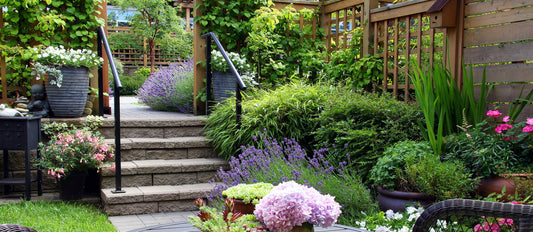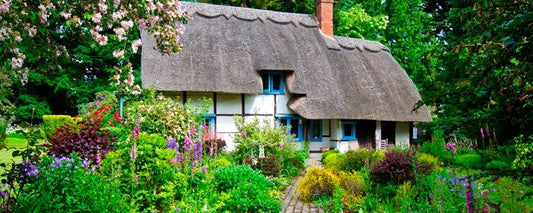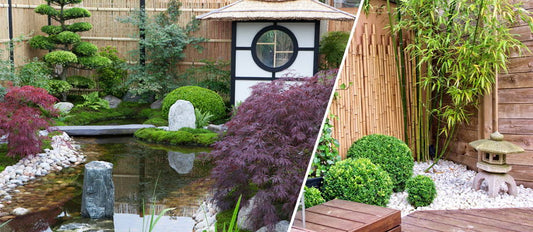Climbers become more popular every year and it isn’t surprising, particularly in smaller gardens where space is at a premium. They are perfect for vertical gardening and don’t need a lot of space, instead giving a wonderful illusion of spaciousness.
Self-clinging climbers
Although many other plants are mistaken as self-clinging climbers there are actually only five; ivy, climbing hydrangea, Euonymus, the Trumpet Creeper and the Virginia Creeper. These plants will only have to be pointed into the right direction once. Virginia Creeper, in particular, is a beautiful cover for a trellis, pergola or garden gate. The aerial rootlets on the shoots will attach themselves to any available support, including trees. If they find no vertical surface to climb, they will turn into ground covering plants since, wherever the roots touch the ground, they will develop normal roots. As each plant section can develop viable roots, taking cuttings is an easy way of making many new plants from the mother plant.
Ivy: why it is one of the best climbing plants?
Ivy has a juvenile and a mature stage, as long as the plant can climb and it is pruned regularly it will remain in the juvenile stage. However, from the moment the branches can't find a surface to cling to, the growth limit is reached and something peculiar happens. The plant changes its appearance and produces side branches that grow rather bushy, the leaves take on a diamond shape and the plant loses the ability to produce aerial rootlets.
From this moment on the plant will flower each autumn, displaying ball-shaped green to yellow flowers which actually consist of lots of little flowers and nectar that is very popular with bees and butterflies. After flowering, small green fruits develop that turn to a decorative black during the winter. If you were to take a cutting from this part of the ivy, it would not turn into a climber but into a shrub called Hedera helix 'Arborescens', possessing quite different hereditary properties to the original plant. This non-climber can be planted in your garden as an evergreen shrub or in a pot. Its growing branches displaying fresh green leaves that are very decorative in flower bouquets, particularly when the fruits are ripe and dark.
The Ivy exists in many varieties
We all know the ivy growing in woods with amazing triangular-shaped deep-green shiny leaves. There are, however, many different varieties, with leaves in different shapes and sizes. Heart-shaped, almost round, pentagonal, frilly, pointy, shiny, matt, bright green or with light yellow rims, pale yellow with green spots, deep green with a bright yellow heart, greyish leaves, they are all real gems. And leaf sizes can vary enormously, just like the colour variations. Some have leaves of just a few cm across while others can be some 15 cm across.
There is a variety for every place and every style. The green types always look very decorative on a sunny wall or fence, particularly when you let a climbing rose grow through it. The flowers look even better against a green background while the sunlight will put a sparkle on the shiny leaves. The variegated cultivars, like the Hedera helix Kolibri (almost white with green speckles) or the creamy white, yellow-rimmed Hedera helix Eva, or the golden yellow, green-rimmed Hedera helix Goldheart all really brighten up dark spaces.
Ideal climbing plants for shaded areas
If you have a shady wall or fence you will need a climber that thrives in shade and ivy will cope in the deepest, darkest shade. The variegated forms will even help to lighten up dark corners of the garden.
Growing, pruning and shaping the Ivy:
There are many more reasons to go for ivy. It is a very easy growing evergreen with no need for a certain type of soil, although some do prefer a slightly acidic soil. Ivy grows in either full sun or deep shade, or anything in between.
To ensure your green or variegated wall stays pretty and does not get too thick, regular pruning with the hedge shears is essential. Cut back new branches growing towards window frames or other painted woodwork immediately. The aerial rootlets leave nasty marks when removed.
Ivy is also very easy to shape. A ball, spiral or even animal shapes are possible. The small-leafed cultivar Hedera helix Baltica is very suitable. Place the ready-made wire shape over the young plant and train the branches through it. Everything that grows outside the shape can be pruned back. In a formal garden you can also grow ivy into a cubic shape. Make a frame with some small beams and wire and place an ivy on each corner. Within a few months you will have an evergreen cube.
Another creative idea is to stretch thick ropes loosely between poles and across the front of your house. You can train the ivy around the ropes and, although the regular pruning needed can be a bit of a time consuming job, the effect really is magical.
Malicious tales
The tendency for ivy to leave marks has generated many malicious tales about this plant. There is the rumour that ivy ruins the joints in your wall. This used to be the case when mortar contained lime, but houses built after about 1920 are usually safe. If you doubt the quality of your pointing, scrape a joint using a small knife. If this leaves deep marks it is better to use another climber or, to be precise, an espalier. If the joints are strong, ivy will not damage your walls and can even have an insulating effect, since rainwater runs off the leaves and does not reach the wall anymore.




